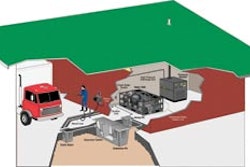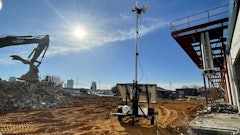While most pavement maintenance contractors have probably heard of "cycle time" some may not be comfortable or used to measuring cycle time. Cycle time is the time that it takes for a work process to be successfully completed, from start to finish.
In the end crew cycle time is a measure of your crew's speed at work.
For the sealcoating contractor, cycle time could represent the time needed to completely clean and prepare a commercial parking lot for seal coating. For the paving contractor it might represent the time to complete the ground preparation for commercial site and then the time spent actually putting the base in or the two-inch overlay. For the sweeping contractor it could represent the time that it takes for a truck to sweep the average 50,000 square feet of parking area for a strip mall.
Cycle time is closely monitored in most manufacturing facilities. Plant managers realize that if the cycle time to produce a product should be 15 minutes, and the actual time is taking more like 20 or 30 minutes, something is preventing the expected time to produce the product. Such interruptions to the expected cycle time might be the result of faulty equipment, lack of preventive maintenance, or poorly trained operators.
Speed, or more accurately, cycle time, should be just as critical to you as a contractor and should be measured. Why?
Consider how much more effective and accurate you can be with your estimates when creating proposals for customers. If you can predict, within a reasonable tolerance of time, the time that it takes for your crews to complete different work processes you can provide more accurate estimates of costs and scheduled completion dates for your customers.
How do you measure your crew's speed or cycle time? Well, to begin trying writing the steps involved with completing the work your crews perform. We call this "mapping" the workflow. Mapping can include simply listing each step in the order that the step is to be performed. Or you can create "work flow charts" that utilize symbols to represent action, decisions, begin points, end points, etc.
No matter whether you list your job procedures line by line or with graphics, make sure that your entire job process is complete and takes into account each individual step. For the paving crew this first effort might identify each step in cleaning a job site as one work process to measure. You might then list each step involved with laying the asphalt for a particular square foot of space. You might follow-up this effort with the steps involved with rolling out the newly placed material. Finally, you might actually identify the needed steps to clean-up and pull off the lot.
The next step requires you to identify the actual time that it takes to complete each process step you "mapped out." If you do not have this information, or you are not confident that the time is accurate, you will need to complete a time study of any step in question.
Over the years I've had contractors challenge how difficult it is to measure the time when performing work. For many of these same challenges I've found that some contractors never attempt to measure any work process. Another reason that contractors balk is due to their feeling that they already know how much time it should take a crew to complete a work process.
Yet a third reason some contractors protest is that "no two jobs are ever the same." While most jobs are a bit different we still need to get an accurate picture of how effective and efficient our crews are working. Are they only productive on the big, open, and easy-to-place asphalt jobs but we lose our shorts if there are any islands or funky landscaping pattern in the lot? This is even more reason why we need to have an idea as to what our crews are capable of producing.
Cycle times can be established for any process within your business. Once you have established cycle times, make sure that you inform your employees. Cycle times should become the standard operating goals for completing jobs. Therefore, when processes take longer than expected to complete, compared to the established cycle time standard, questions should be raised as to the possible causes for the additional time. Remember, time is money…I mean speed is money!
Next issue: Determining and applying your crew's cycle time.
For more information on establishing cycle times for your crews contact Brad Humphrey of Pinnacle Development Group. You may contact Brad by visiting www.pinnacledg.com.



















